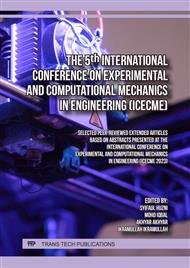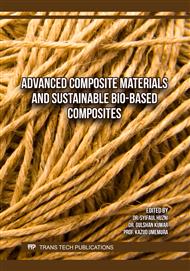p.11
p.17
p.23
p.31
p.39
p.47
p.55
p.65
p.71
Study of Abaca Fiber Orientations on Mechanical Properties
Abstract:
Research on composites reinforced with abaca fiber is still being carried out. Research about fiber treatment, research about mixing abaca fiber with other natural fibers, or mixing abaca fiber with synthetic fiber, as well as the types of matrices used and research on differences in fiber orientation to determine its strength still being conducted. This research aims to study the mechanical properties of abaca fiber orientation on abaca fiber reinforced composite. The fiber is abaca fiber (Musa Textiles Ne) and the matrix is epoxy resin. The abaca fiber is first soaked in alkaline NaOH solution with a ratio of 5wt % to water for 2 hours. After being washed thoroughly and dried, the abaca fiber is prepared in 3 orientations, the first is woven orientation, the second is unidirectional orientation and the last is random orientation, where the fiber were cut into 20 mm pieces and arranged randomly. The abaca fiber is then mixed with epoxy resin in a ratio of 40% abaca fiber and 60% epoxy resin and pressed to a thickness of 4 mm. According to ASTM D638 standard, tensile strength testing was conducted and flexural strength was conducted according to ASTM D790 standard. The results show that the tensile strength of woven orientation is 63.1156 MPa and fiber with a unidirectional orientation is 62.4829 MPa and fiber with a random orientation is 22.3517 MPa. The elastic modulus of woven, unidirectional and random orientations are 3.6425GPa, 3.9734 GPa, and 1.6449 GPa, respectively. Bending test results show that random orientation is more flexible than woven and unidirectional orientation, where the strain value is 0.0408 mm/mm, 0.0393 mm/mm, and 0.0369 mm/mm, respectively. The flexural modulus of the three different orientations is 0.8082 GPa for random orientation, 1.2176 GPa for woven orientation and 1.675 GPa for unidirectional orientation. It can be concluded that the tensile strength of woven orientation increases by 1% to unidirectional orientation and 182% to random orientation. Compared to the three different orientations, random orientation has higher bending properties than woven and unidirectional orientation, and woven orientation is still more flexible than unidirectional orientation.
Info:
Periodical:
Pages:
39-46
Citation:
Online since:
May 2025
Authors:
Keywords:
Price:
Сopyright:
© 2025 Trans Tech Publications Ltd. All Rights Reserved
Share:
Citation:



